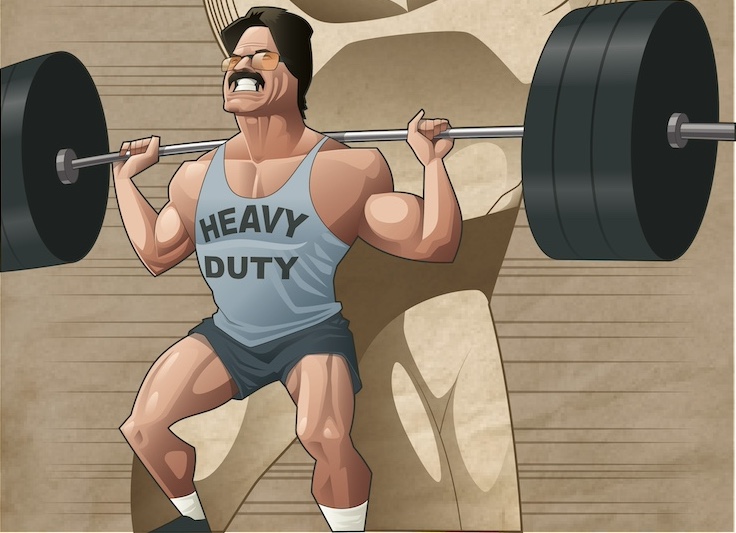Legendary bodybuilder Mike Mentzer’s training philosophy emphasized brief but intensely focused workouts with ample time for recovery. But does such an approach work for the regular gym-goer?
In the realm of bodybuilding, there are legends, and then there’s Mike Mentzer. Crowned Mr. Olympia Heavyweight champion in 1979 and the only Mr. Universe recipient to achieve a perfect score, Mentzer is one of the greatest bodybuilders of all time. However, what truly turned heads was his unconventional approach to training. While his peers pounded the gym floor six days a week, clocking in hours upon hours of training, Mentzer took a radically different path with low-volume high-intensity training. His workouts were short, sharp, and sparingly spaced.
Embracing the principles of high-intensity training (HIT) popularized by Arthur Jones in the 1970s, Mentzer made his most significant gains through brief yet intense workouts. Advocating as little as one or two sets per body part every fortnight, he challenged the conventional wisdom of the bodybuilding world. Such defiance didn’t come without its critics. Mentzer faced heavy scrutiny and was often labeled an outsider in the bodybuilding community. But for those juggling the demands of work and family, his approach offered a glimmer of hope. In a world where time is a precious commodity, his philosophy hinted at the possibility of achieving a solid physique with minimal hours spent in the gym.
Mentzer’s low-volume high-intensity training methodology wasn’t just about building muscle; it was about doing it in the most time-efficient manner possible. Imagine condensing hours typically dedicated to training into just a fraction of that time. If Mentzer’s methods really could deliver results, then perhaps the hours typically dedicated to training could be condensed to fractions of what we’re accustomed to.

Trimmed-back training with low-volume and high-intensity
Mentzer’s HIT methodology focuses on performing minimal sets with maximum effort. For instance, conventional wisdom might prescribe a grueling regimen of 12 to 16 sets per week dedicated to chest exercises. Mentzer’s low-volume high-intensity training, however, suggests just one set per body part each week. The underlying theory is simple yet profound: by scaling back both the volume and frequency of your workouts, allowing your body ample time to recover and grow becomes the priority. Mentzer was adamant that rushing back into the gym too soon would shortchange your gains, often preaching a full week of rest between workouts.
But that solitary set must pack a punch. It’s about pushing yourself to the brink of failure with heavy weights and low reps, using techniques like negative reps, forced reps, static holds, and rest-pause sets. Mentzer’s philosophy was clear: one set taken to absolute failure is all it takes to spark muscle growth. Anything beyond that would spell overtraining and hinder progress.
Core principles of low-volume high-intensity training
Delving deeper into Mentzer’s revolutionary approach, I had the privilege of conversing with John Little, a close confidant of the late bodybuilder and co-author of his seminal work, High-Intensity Training the Mike Mentzer Way. Little outlined three foundational principles of low-volume high-intensity training. First, the necessity of training with enough intensity to trigger an adaptive response. Second, avoiding excessive training duration that compromises intensity. And third, refraining from subsequent workouts until the body has adequately recovered and adapted.
The proof is in the lifting
I embarked on a modified rendition of a classic Mike Mentzer routine, dictated by two gym sessions per week, each capped at a concise 30 minutes. Stepping into the gym and exiting within the hour, fully aware that my workout was done for the week, felt surreal. Embracing not just the positive sets but also incorporating techniques like rest-pause and negatives injected a new dimension into my training.
To my astonishment, after just one month, not only had I managed to stave off muscle loss, but I even sensed growth in certain areas – notably my biceps and chest. Considering I had slashed my training time by 75%, the results were impressive. Friends noticed my conspicuous absence from the gym, and when I did make an appearance, my workout concluded before their warm-ups had barely begun. Suddenly, I found myself with ample time for work, family, and avoiding rush-hour traffic. It was liberating.
More than muscles
Training has become as important to my mental wellbeing as it has my physical health. The high-intensity cardio sessions I cherished were among the casualties of adopting low-volume high-intensity training. Seeking reassurance, I turned to John Little, who advised against compromising physical progress for socializing. Despite the challenges and occasional detours into extra cardio sessions, I was heartened to witness tangible progress after eight weeks.
Mentzer’s low-volume high-intensity training principles proved effective, yielding significant results with minimal gym time. His success story and coaching legacy, including luminaries like Dorian Yates, underscore the efficacy of this methodology. For anyone searching for a harmonious gym-life balance, low-frequency training offers a compelling solution. With newfound hours to spare, you can delve into pursuits beyond the gym. And if you’ve sweated it out like Mike Mentzer, you will have earned it.

TRAINING TIPS
General advice for anyone taking on Mike Mentzer’s low-volume high-intensity training approach.
1. Warm up. Before your one working set, perform around 3 warm-up sets, increasing the weight with each set. Your final warm-up set should be around 75% of your working weight. Never reach failure in your warm-up sets.
2. Go all out. With just 1 set, you have to go to complete failure. Throw in intensity techniques including negative reps, forced reps and rest-pause into different sessions – no two workouts need be the same. Regardless of how high the intensity, maintain correct form throughout.
3. Use a log book. As John Little explained, “Mike recommended you worked out with a logbook close by so you can assess progress. If you are moving in a positive direction, then the intensity, frequency and recovery are on point – but if progress arrests, you can look at the logbook and determine why.”
4. Recover. Good recovery is paramount to progress. You should rest at least 48 hours between workouts, preferably between four to seven days. Prioritise good nutrition and hydration, and give precedence to sleep.
5. Avoid extra sessions. When following HIT principles to the letter, there really is no room for extra cardio sessions, which eat into your recovery and curb your gains. If you aren’t concerned with growing and simply want to use these principles to maintain your physique, then the odd cardio session coupled with adequate recovery probably won’t harm.
THE LOW-VOLUME HIGH-INTENSITY TRAINING PLAN
Throughout his career, Mike Mentzer outlined many training programmes, all varying in length and exercise selection. I followed an adapted plan from his book High-Intensity Training the Mike Mentzer Way.
Workout instructions:
- ‘a’ exercises are ‘pre-exhaust’ sets, so go straight into the ‘b’ exercises with no rest
- Perform 1 set of each
- Keep rest to a minimum between sets
Workout 1
1a. Leg extension x 12-20
1b. Leg press x 12-20
2. Standing calf raise x 12-20
3a. Dumbbell flye x 6-10
3b. Incline press x 1-3
4. Triceps pushdown x 6-10
Workout 2
1a. Straight-arm pulldown x 6-10
1b. Palms-up pulldown x 6-10
1c. Deadlift x 6-10
2a. Dumbbell lateral raise x 6-10
2b. Bent-over dumbbell lateral raise x 6-10
3. Barbell curl x 6-10
4. Weighted sit-up x 12-20







